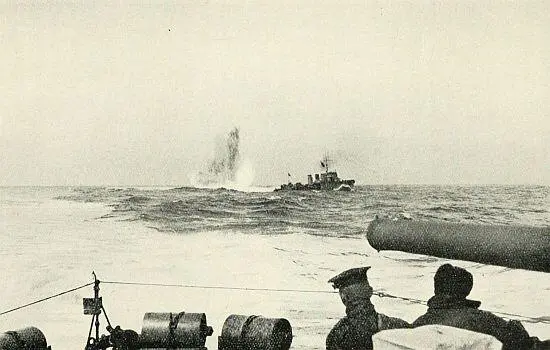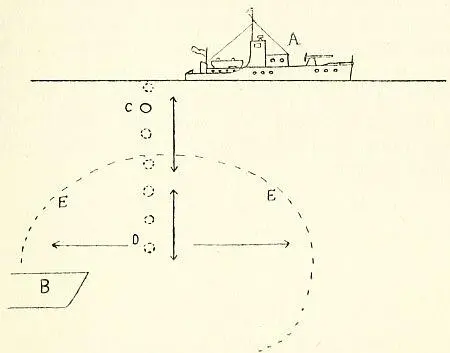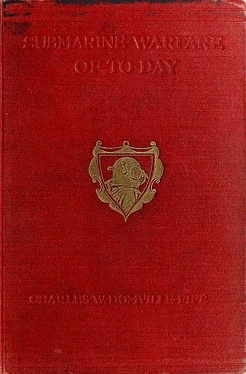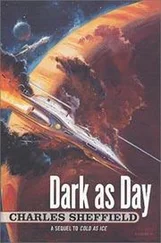
British Official Photograph
Dropping Depth Charges
It often happened, however, that neither one nor the other of these things occurred, but that the submarine’s delicate electrical machinery was thrown out of order by the violence of a depth-charge explosion, even when a considerable distance away. With the electric engines used for submerged propulsion no longer available, and possibly the interior of the vessel in darkness, there were only two courses open. She could either rise to the surface and endeavour to fight it out with the aid of her powerful deck guns, or else sink to the bottom and trust to luck that other depth charges would not be dropped close enough to seriously damage her hull. In the open sea, however, the latter chance was denied because of the depth of water. Three hundred feet may be taken as the greatest depth to which an ordinarily constructed fighting submarine can safely descend without running a grave risk of having her plates crushed in by the great water pressure. Even at this depth the weight on every square foot of hull surface exceeds 8¾ tons.
If the damaged submarine rose to the surface the guns of her pursuers were ready and could generally be relied upon to place her at least hors de combat before the hatches of the under-water vessel could be opened and her own guns brought into action.

Fig. 9.—Diagram showing how depth charges are carried on the stern of a motor launch. AA. Depth charges, each containing 300 lb. of high explosive. B. Hydrostatic device by means of which the charge can be made to explode when it has sunk from the surface to a depth of 40 or 80 feet, and by which it is rendered comparatively safe while on deck. C. Slings holding charges in place on inclined platform. D. Greased bolts which, on being pulled out, allow wire slings to fly free and depth charge to roll into the sea. Depth charges can only be released from vessels under way, otherwise the explosion which occurs a few seconds after release damages surface vessel.
In shallow water where there was a fairly smooth bottom it generally happened that a submarine damaged by depth charges elected to sink to the sea-bed and trust to luck. This was also frequently resorted to as a means of eluding pursuit even when the U-boat was not damaged by the first few charges dropped. It was then that the hydrophones carried by the surface ships were again brought into use to ascertain if the submarine was still under way. When no sound was heard those on the surface knew that “Fritz” was lying doggo, or else that he had escaped. If a number of ships were available a few waited over the spot where it was considered the U-boat was lying, while the others scoured the surrounding seas in circles trying to pick up the sound of the runaway’s engines if she had escaped in the mêlée. When nothing further was heard they returned to the scene and set about the work of systematically bombing the surrounding sea-bed.

Fig. 10.—Diagram illustrating a depth charge attack on a submerged submarine. A. Motor launch, which has dropped a depth charge to destroy a submarine B travelling at a depth of 90 feet below the surface. C is the depth charge sinking as the M.L. steams away from the danger area. D is the point (80 feet below the surface) at which it will explode, and E indicates the danger area for the submarine B .
As many as one hundred depth charges were dropped in quite a small area of sea and yet a submarine known to have been lying “doggo” in the locality was not damaged. In cases such as this other means, which will be described in a succeeding chapter, were then resorted to.
All the foregoing sounds very thorough and hopeful, but in fairness it must be said that submarine hunting is a heart-breaking task. The reader may have noticed that the method of depth-charge attack presupposes the surface vessel to have attained a position almost directly over the top of her enemy, a manœuvre extremely difficult of achievement even with the most efficient hydrophone. Heavy seas, snow and fog have also to be taken into consideration, to say nothing of darkness, the presence of a second submarine, a surf-beaten rock or sandbank and the confusing sounds of passing merchant ships, making a difficult task more difficult, as will be seen when we come to the actual fighting.
CHAPTER VI
Some Curious Weapons of Anti-Submarine Warfare
Although modern war has shown that there exists no certain antidote for the submarine, it nevertheless brought into being many curious weapons of attack and defence. It is the purpose of this chapter to describe some of the anti-submarine devices used with more or less successful results during the protracted naval operations against the Central Powers.
Among the most important of these were the immense meshes of wire known as “indicator nets,” which were used to entangle a submarine and then to proclaim her movements to surface ships waiting to attack with guns and depth charges.

Fig. 11.—Diagram showing principal features of a line of submerged indicator nets. AA. Two sections (100 feet in breadth) of thin wire-netting with a very wide mesh. B. Framework of wire rope holding each section of net in place by means of metal clips C . C. Metal clips which expand and release netting from rope frame when a pull of more than 100 lb. is exerted upon them. D. Line of invisible glass balls, or hollow floats, attached to a surface wire E , supporting by wires F , the nets which hang down from the surface vertically in long lines (½ to 1 mile in length and 50 feet deep). G. Heavy iron weights or sinkers holding down the nets by their weight when hanging in water. H. Wooden floats, attached to each section of net by wires I . J. Canisters of chemical which give off flame and smoke when exposed to sea-water. K. Lanyard attached to surface wire E . When a section of net is pulled out of its wire frame by a submarine passing through the line the float is dragged along the surface by the wire I . The lanyard is held back by being attached to surface wire E , and pulls a plug out of the canister J , exposing the chemical inside to the sea-water (see Fig. 12 Fig. 12.—Diagram showing a submarine entangled in a submerged net. The submarine A after passing through a line of nets emerges with her bows enveloped by one section B which she has carried out of its wire-rope frame. The flaming buoy C , betraying her movements, is being towed along the surface. A considerable measure of success attended the use of this ingenious device until “Fritz” became shy of waters close inshore, and kept a careful look-out for possible lines of indicator nets when forced to pass through narrow channels and waterways. One of the main disadvantages attending the use of these nets was the impossibility of laying them—or, when laid, of hauling them inboard again, during even moderately rough seas. Another difficulty which presented itself when indicator nets were required to be laid in the open sea was the screening of the waiting surface ships from observation. Submarines could not be used on account of their slow speed, and when fast patrol craft cruised about openly within easy range of the nets “Fritz” suspected a trap and steered clear. Even this, however, had its uses.
).
These nets were made of specially light but strong wire, with a mesh of several feet. They were joined together in lengths of 100 feet by metal clips which opened when a certain strain was exerted on any particular section. Their depth was usually about 50 feet, and they were laid in lengths varying from a few hundred yards to two miles. Weights at the lower end and invisible glass floats along the top held them suspended vertically from the surface. The floats were kept in place by a wire hawser running along the top of the nets, and to this were attached, at intervals, wooden buoys containing tin cases filled with a chemical compound which, when brought into contact with sea-water, emitted dense smoke by day and flame by night.
Читать дальше
















